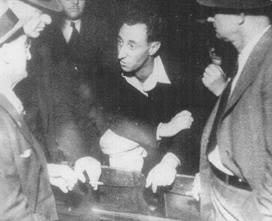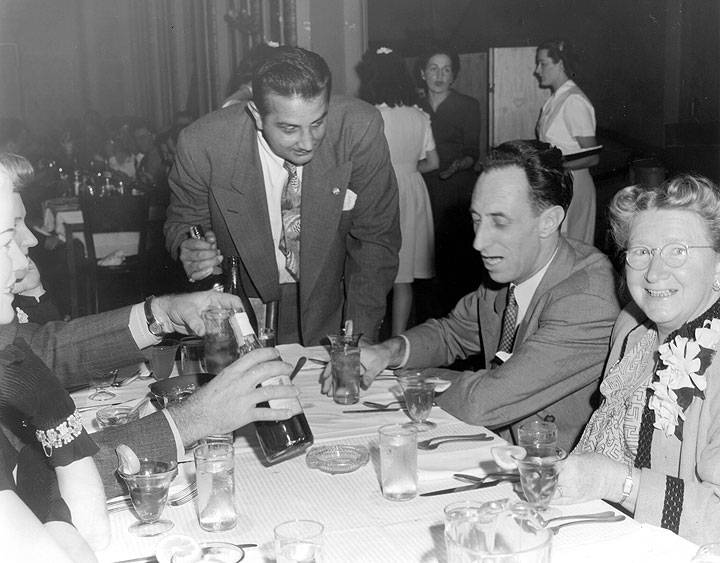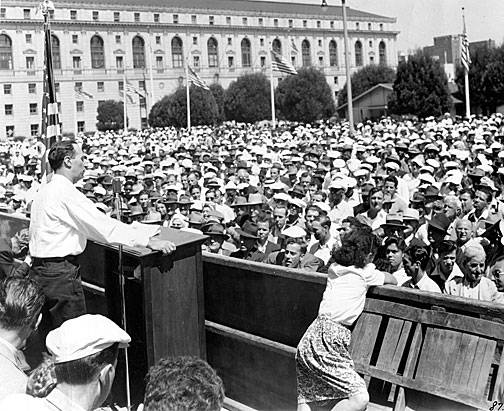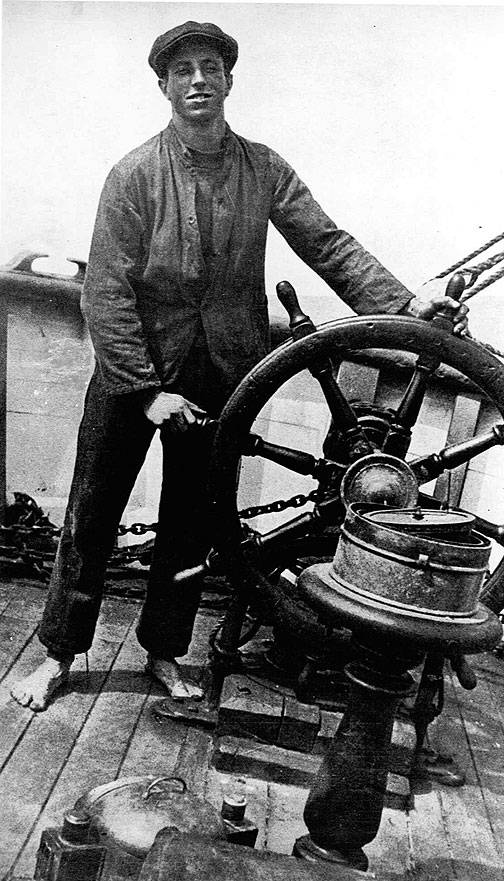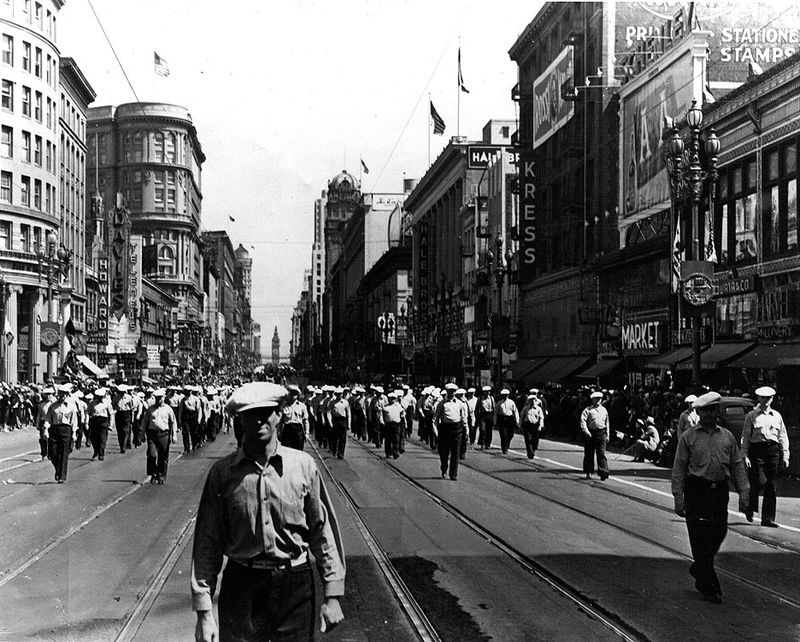Harry Bridges
Historical Essay
by Harvey Schwartz, a San Francisco-born labor historian
<iframe src="https://archive.org/embed/hidden-san-francisco-stop-l-11-harry-bridges-plaza" width="640" height="480" frameborder="0" webkitallowfullscreen="true" mozallowfullscreen="true" allowfullscreen></iframe>
![]()
Next Stop #8: Carving Hills
Harry Bridges at a negotiating session during waterfront strike, 1934.
Photo: San Francisco History Center, San Francisco Public Library, San Francisco, CA
Harry Bridges at the Longshore caucus, 1945.
Photo: ILWU Archive
Harry Bridges retired in 1977 amid the accolades of almost everyone associated with the West Coast shipping industry. Unionists, shippers, media people and government officials joined in a chorus of praise for the historic longshore leader, who had served as the first and only president of the International Longshoremen's and Warehousemen's Union (ILWU) for the preceding forty years and had led the coast's militant dock workers as they fought for their survival as unionists during the great maritime strikes of 1934 and 1936-37. The 1930s had been turbulent years for Bridges and the longshoremen: the 1934 strike had, for a few days, swelled into a general protest strike in San Francisco after police killed two waterfront pickets; the 1936 strike had been marked by a bitter propaganda contest. But after a major longshore walkout in 1948, the shippers had finally decided to live with Bridges, and a new look had come to the waterfront. In 1960 Bridges negotiated an innovative mechanization and modernization agreement to cooperate with management so that the coast's port facilities might be modernized without continual industrial warfare.
With the signing of that contract Bridges was hailed as a great labor statesman.
Harry Bridges addressing Civic Center Labor Day rally, 1947.
Image: ILWU Archives
So the famous longshore leader became an ILWU pensioner in 1977 with the applause of his fellow unionists and former foes alike. In anticipation of his retirement he was treated to a grand testimonial dinner at the Fairmont Hotel in late 1975. Messages of congratulation were conveyed to him from such diverse sources as Leonard Woodcock, President of the United Auto Workers; the United States Air Force Reserves; Nelson Rockefeller, Republican Vice-President of the United States; the Kerr Steamship Company; the managers of the six Bay Area ports; Frank Fitzsimmons, President of the International Brotherhood of Teamsters; and the Sea-Land container company. Robert J. Pfeiffer, President of the Matson Navigation Company, was among the many who spoke in praise of the retiring unionist. By January 1978 Bridges was in Washington, D.C., at the invitation of officials of the National Portrait Gallery, to discuss with them the possibility that his picture might hang in that place of honor some day. Bridges regarded these accolades with typical skepticism. Reflecting upon the public acclaim he had received since he left office in mid-1977 Bridges told a reporter that he had noticed that when the old bastards retired, people would say "He's not so bad after all."
But of course Harry Bridges had not always enjoyed such public acceptance and high esteem. For much of the first thirty-five years of his life he had labored as an unsung sailor and longshoreman in an era when marine workers commanded little respect in polite society. He had been born Alfred Renton Bryant Bridges in a suburb of Melbourne, Australia on July 28, 1901. As a youth he had rejected his father's real estate business and conservative politics and had instead followed the example of two uncles, especially Harry Renton (variously a sailor, miner, and pearl diver, whose name he eventually adopted) who championed the militant Australian trade union movement and its Labour Party. As a teenager, he had become a seaman, mingling on shipboard with Australian members of the American [born] radical Industrial Workers of the World (IWW) and, while at port in Melbourne, witnessing the tumultuous 1917 Australian general strike.
Harry Bridges as a young seaman.
Photo: ILWU Archives
Bridges had jumped ship at San Francisco in 1920, found employment in American vessels as a member of the Sailors Union of the Pacific, and briefly joined the IWW himself during a strike at New Orleans in 1921.
The next year he had returned to San Francisco to settle as a longshoreman. In pursuing his new career Bridges found the conditions of labor on the City's waterfront to be among the world's worst. During his early years as a longshoreman, he was subjected to the favoritism and kickbacks that characterized the hiring of dock workers from an early morning gathering called "the shape-up." He worked the grueling all-day and all-night shifts at an unrelenting speed that caused an appalling number of waterfront accidents, and was himself twice injured. "If I had a chance to work I grabbed it," the retired longshore leader recalled recently, "even if it was twenty-four hours. I was hungry as a bastard." Bridges attempted to avoid the shipowners' "Blue Book," or company union, by moving continually from dock to dock in search of casual employment. Finally he joined in order to gain steady work. He became a member of one of the waterfront's hard-driving "star" gangs and gained a reputation as a stalwart longshoreman. But he never stopped thinking about the need for a rebirth of worker-controlled unionism. He was one of a number of activists who struggled successfully in the early 1930s to revive the defunct International Longshoremen's Association (ILA), the ILWU's predecessor on West Coast docks. Bridges actively participated when the rejuvenated ILA closed all Pacific Coast ports during the long and bloody 1934 strike, which ended with the replacement of the shape-up by a union-controlled hiring hall. In the course of that fateful strike, Bridges -- who had a deserved waterfront reputation for honesty and militancy that he would keep throughout his career -- emerged as the longshoremen's clear rank-and-file leader, in part for his advocacy of the general strike weapon, which had been a favorite of IWWs in America and Australia alike before World War I. Honesty, militancy, leadership, and even fame, of course, hardly brought Harry Bridges the universal public acceptance and high esteem he would enjoy when he retired. Between the mid-l930s and the mid-1950s federal agencies made numerous attempts to deport the unionist who had neglected to get his naturalization papers in order before he became famous -- as an alien radical. For much of that twenty-year period Bridges was forced to defend himself in hearings and in court.
Conservative agitation to expel Bridges as a member of the Communist Party, USA, began in 1934. His opponents pointed out that deportation was not technically a punishment for crime, but was merely an administrative process for the return of unwelcome aliens to their native countries, and could, at least theoretically, be easily effected. Following an investigation in 1936, though, Immigration and Naturalization Service officials reported that no basis existed for deportation proceedings against the labor leader.
1939 Labor Day March on Market Street led by ILWU
Image: ILWU Archives
<iframe src="https://archive.org/embed/labor-day-1939-llsf-2015-20151208-30p-7-mbps" width="640" height="480" frameborder="0" webkitallowfullscreen="true" mozallowfullscreen="true" allowfullscreen></iframe>
Video: from "Lost Landscapes 10, 2015" courtesy Prelinger Archive
Nonetheless, Bridges was soon charged with belonging to an organization which sought to overthrow the government by force. A highly publicized deportation hearing was held on Angel Island near San Francisco in 1939. Dean James M. Landis of the Harvard Law School was retained as trial examiner for the Department of Labor, which then had administrative jurisdiction in matters of immigration. The Supreme Court had recently determined that federal statute necessitated proof of membership in a proscribed organization at the time of arrest as reason for deportation. After eleven weeks of hearings, Landis decided that the evidence failed to show that Bridges had been a Communist Party member when the warrant for his arrest had been issued.
Unfortunately for Bridges, Congress soon enacted the Alien Registration Act of 1940, known as the Smith Act, making past member-ship in organizations like the Communist Party reason for deportation. The next year he was subjected to another hearing, this time before Judge Charles B. Seras, trial examiner for the Department of Justice, which had recently taken over the Immigration and Naturalization Service from the Labor Department. Sears decided that Bridges was subject to deportation and Attorney General Francis Biddle, who had final say for the Justice Department, agreed. Biddle ordered Bridges deported in 1942, but the complex set of appeals which followed landed the case in the Supreme Court. In 1945, by a vote of five to three, the Court held that Communist Party affiliation had not been proved. Later that year Bridges signed his naturalization papers after attesting that he had never been a member of the Communist Party. But when the McCarthy period dawned, the "everlasting Bridges case," as it became known, was reopened. In April 1950, the longshore leader was found guilty of having given false testimony during his naturalization proceedings. He and his two witnesses in the oath-of-citizenship ceremonies, J.R. (Bob) Robertson and Henry Schmidt, both ILWU officials, were also convicted of conspiracy to defraud the government.
A few months later, while he awaited legal appeal, Bridges' bail was revoked when U.S. District Court Judge George Harris, who had presided at the perjury trial, decided that the unionist was a danger to national security since he was critical of American intervention in the Korean war. Bridges was jailed for three weeks during August 1950 before being released under bail by the U.S. Court of Appeals. In 1953 the case reached the Supreme Court, which set aside the conviction of Bridges, Robertson and Schmidt because their indictment had occurred over three years after the statute of limitations provided for in such criminal cases. A final effort by the Justice Dept. to deport Bridges ended in 1955 when Judge Louis E. Goodman dismissed the department's civil action to denaturalize the ILWU President.
During the two decades of the Bridges hearings and trials, every phase of the labor leader's personal and union life was examined repeatedly. But in the end the government's prosecutors, who employed perjured witnesses with shocking regularity, failed to establish Bridges' membership in the Communist Party and were unable to achieve his deportation. Viewing the Bridges case when all of the proceedings were nearly completed Milton R. Konvitz, an expert on the civil rights of immigrants, observed accurately that the Bridges trials could be interpreted as "an instance of nineteen years of relentless persecution," and concluded that "it was our administration of justice that was on trial; and the verdict of history will probably be that, taking the case as a whole, as it extended over a period of nineteen years, it was America . .. that lost the case."
From the perspective of time it is clear that Bridges was hounded for years by American government officials and others who clamored for his deportation because, as CIO President Philip Murray insisted pointedly in 1945, the longshore leader "was guilty of the crime of organizing the unorganized." But there was obviously more to it than that. Bridges was not the only aggressive organizer in the 1930s. Yet he was an extraordinarily successful, opinionated and well-known labor leader from 1934 on, and so, as an alien who was slow to become a naturalized citizen, he presented an inviting target to all opponents of labor on the march, which he symbolized. The specific charge of Communist Party membership came easily because of his tolerance of Communist unionists and his outspoken political views.
The so-called evidence against him was repeated over the years by Bridges' opponents and by many indifferent observers who unquestioningly accepted it. Bridges admitted belonging to the IWW as a youth in the early 1920s, even though he had soon given up his association with that organization because he thought its advocacy of anarchism and its neglect of collective bargaining impractical. He had accepted aid from the Communist-affiliated Marine Workers Industrial Union before and during the 1934 strike, and always insisted afterwards that he would have taken aid from anyone in that period of struggle for his union's very survival. He tolerated and even welcomed Communist Party members in the longshore union, frequently observing that they always seemed to make good unionists. He supported numerous unpopular political causes, including Upton Sinclair's "End Poverty in California" (EPIC) campaign for the governorship of the Golden State in 1934, the United Labor Party's unsuccessful bid for the San Francisco mayoralty in 1935, and Henry Wallace's ill-fated anti-Cold War Progressive Party candidacy for the presidency of the U.S. on the verge of the McCarthy period in 1948.
He was never reluctant to elaborate on his belief that there was a class struggle during the Depression: "We as workers have nothing in common with the employers" he told an audience gathered at the University of Washington in the mid-1930s. "We are in a class struggle, and we subscribe to the belief that if the employer is not in business his products will still be necessary and we still will be providing them when there is no employing class. We frankly believe that day is coming." More important, he openly expressed interest in the Soviet experiment, favored a Western-Soviet alliance against fascism in the latter 1930s, condoned the Nazi-Soviet Non-Aggression Pact and called for U.S. neutrality in the European war during 1939-1941, and then demanded all-out American support for the beleaguered Russians after Hitler's June 1941 invasion of the Soviet Union. As Richard L. Neuberger wrote in 1939, to millions of Americans no one so epitomized "labor revolt and extremism" as Harry Bridges. To many he was "the national bogeyman, a symbol within our own country of revolutionary tendencies and dangerous ideas."
Yet in the 1930s, when many historians -- still influenced by Charles Beard's economic interpretation of history -- were sympathetic to the new unions, labor scholars seemed resistant to the kind of red-baiting of Bridges found in non-academic books like Paul Eliel's chronicle of the 1934 strike, which appeared soon after the crisis. Eliel, an employee of the business community's San Francisco Industrial Association, condemned Bridges as a man "who later was proved to have strong Communist leanings if not actually Communistic connections." By the end of the decade such lurid popular books as Martin Dies's The Trojan Horse in America and Eugene Lyons' The Red Decade, which represented Harry Bridges as the Joseph Stalin of American shipping, made Eliel seem moderate by comparison. Some of the earliest publications by professional scholars, however, were quite balanced in their treatment of Bridges and his movement. "Whether Bridges is or is not a Communist is extremely difficult to prove," wrote the University of California's Paul S. Taylor and Norman L. Gold in an article printed a few weeks after the 1934 strike. "Certainly neither the marine strike nor the [San Francisco] general strike were basically communist strikes. . . In 1934 the presence of Communists on the scene . . . [was] seized upon to defeat aggressive, but essentially orthodox unions and unionists." In the spring of 1935 Richard T. La Piere, a Stanford University sociologist, characterized Bridges as a genuine rank-and-file leader, "not in any way a communist," even though he seemed to believe "that under conditions as they now exist, labor and capital are opposed." Edward Levinson, a journalist and CIO writer whose 1938 classic, Labor on the March, was seriously regarded by labor scholars, presented a sympathetic and stirring view of the Pacific Coast longshore union's gains under Bridges' leadership. Finally, later in the decade Philip Taft commented on the longshore leader in a pioneering study of the problems facing the nation's new CIO unions. The famous labor scholar was cautious in assessing the recent rift in Pacific Coast maritime union solidarity. "The chief complaint of the West Coast sailors," Taft reported guardedly, "seems to be that Harry Bridges was too close to the Communists."
by Harvey Schwartz, a San Francisco-born labor historian
"Harry Bridges and the Scholars: Looking at History's Verdict" by Harvey Schwartz, originally published in California History, Vol LIX, Spring 1980, No. 1, pp. 66.

